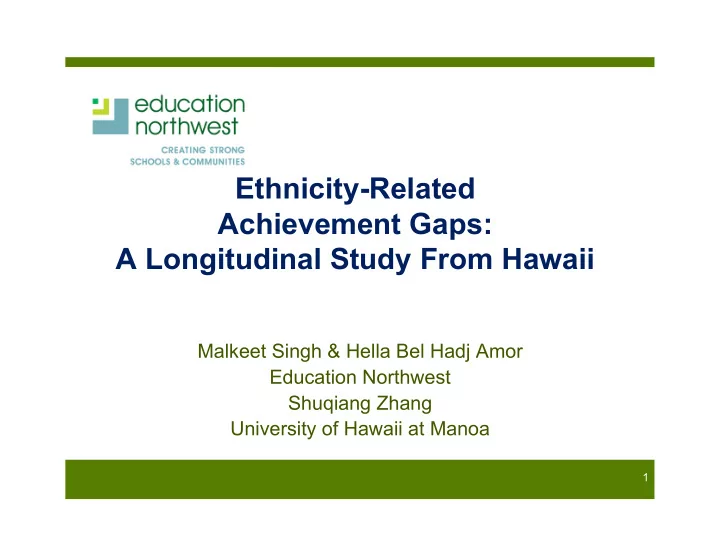

Ethnicity-Related Achievement Gaps: A Longitudinal Study From Hawaii Malkeet Singh & Hella Bel Hadj Amor Education Northwest Shuqiang Zhang University of Hawaii at Manoa 1
Better Outcomes for All Kids � Goal: Improved outcomes for disadvantaged groups and reduced gaps 2
Better Outcomes for All Kids � Goal: Improved outcomes for disadvantaged groups and reduced gaps � How: � Testing in multiple grades � Assessments aligned with state academic standards � Subgroup performance � Incentives and sanctions 3
The design of NCLB limits its ability to achieve its goal Limitations with regard to: • Diversity of Hawaii’s Asian population • Pacific Islander population • Early academic foundation, low SES and ELL status • Nested structure of the data 4
These limitations can be addressed Outcomes • Reading HSA in grade 8 (2009) • Reading HSA in grade 10 (2011) 5
These limitations can be addressed Outcomes Predictors • Reading HSA in grade 8 • Reading HSA in grade 3 (2009) (2004) • Reading HSA in grade 10 • Ethnicity (Hawaiian, East (2011) Asian, Filipino or white) • Gender • SES (FRPL) • School SES (% FRPL) 6
Multilevel Model I Y i(jk) = β 0(jk) + β 1(jk) (HSA 3R) i + β 2(jk) (SES) i + β 3(jk) (East 1 Asian) i + β 4(jk) (Filipino) I + β 5(jk) (Hawaiian) i + β 6(jk) (Gender) i + r i(jk) β 0(jk) = γ 00 + γ 01 (SchSES-3) j + γ 02 (SchSES-8) k + µ 0j + µ 0k 2 β m(jk) = γ m0 m = 1..6 Y i(jk) = γ 00 + γ 10 (HSA 3R) i + γ 20 (SES) i + γ 30 (East Asian) i + γ 40 (Filipino) i + γ 50 (Hawaiian) i + γ 60 (Gender) I + γ 01 (SchSES-3) j + γ 02 (SchSES-8) k + µ 0j + µ 0k + r i(jk) Where i = i th student, j = j th elementary school, k = k th middle school, Y i(jk) =Grade 8 HSA score of the i th student from the j th elementary and the k th middle schools 7
Achievement – Cohort Analytical Sample ¡ Grade ¡ N ¡ Mean ¡ SD ¡ 3 ¡ 5285 ¡ 303.07 ¡ 57.65 ¡ 8 ¡ 5285 ¡ 322.50 ¡ 29.93 ¡ 10 ¡ 5285 ¡ 315.07 ¡ 26.00 ¡ 8
Achievement – Subgroups East Asian ¡ Filipino ¡ Hawaiian ¡ White ¡ Grade ¡ N ¡ Mean ¡ SD ¡ N ¡ Mean ¡ SD ¡ N ¡ Mean ¡ SD ¡ N ¡ Mean ¡ SD ¡ 3 ¡ 1188 ¡ 328.84 ¡ 55.99 ¡ 1642 ¡ 299.08 ¡ 54.12 ¡ 1841 ¡ 283.19 ¡ 53.26 ¡ 614 ¡ 323.45 ¡ 57.37 ¡ 8 ¡ 1188 ¡ 337.22 ¡ 29.63 ¡ 1642 ¡ 322.98 ¡ 27.28 ¡ 1841 ¡ 310.58 ¡ 27.71 ¡ 614 ¡ 328.47 ¡ 28.98 ¡ 10 ¡ 1188 ¡ 328.82 ¡ 25.09 ¡ 1642 ¡ 313.71 ¡ 22.27 ¡ 1841 ¡ 304.48 ¡ 24.37 ¡ 614 ¡ 323.76 ¡ 26.70 ¡ 9
Achievement Mirrors Differences in Poverty Across Subgroups Percent low SES 10
HLM Results ¡ Year/Grade ¡ 2009 (8) ¡ 2011 (10) ¡ Intercept ¡ 338.89*** 328.88*** HSA 3R ¡ 0.33*** 0.27*** Gender ¡ -5.83*** -1.23* Hawaiian ¡ -3.90*** -6.90*** Filipino ¡ 0.81n.s. ¡ -3.83*** East Asian ¡ 4.93*** 2.81** SES ¡ -2.39*** -2.55*** SchSES-3 -0.22*** -0.20*** SchSES-8 ¡ -0.03n.s. -0.05n.s SchSES-10 ¡ N.A. ¡ 0.07n.s. Random Effect ¡ Variance Components ¡ Variance Components ¡ µ 0j ¡ 13.08*** 10.12*** µ 0k ¡ 15.68*** 0.06n.s. µ 0l ¡ N.A. ¡ 11.99** Residual ¡ 436.59*** 342.55*** R 2 ¡ 0.52 ¡ 0.50 ¡ * p ≤ 0.05, ** p ≤ 0.01, *** p ≤ 0.001, n.s. not significant, N.A. not applicable. Numbers in parentheses are standard errors. 11
Standardized Weights ( Z ) Predictor Standardized Coefficients Percentage change Grade 8 Grade 10 HSA 3R 0.01 0.01 0% Gender -0.19 -0.05 74% Hawaiian -0.13 -0.27 108% Filipino n.s. -0.15 N.A. East Asian 0.16 0.11 31% SES -0.08 -0.10 14% 12
Key Findings – Middle School Extent to which Hawaii Native Hawaiian/ middle schools perpetuate ethnic White Gap disadvantage Goal: Insignificant, if not exactly O Model 4 Estimate Usual 18 Includes cumulative Measure socio-economic and academic disadvantages 13
Key Findings – High School Middle High Model 4 7 Estimate Native Hawaiian/White Gap Usual 19 18 Measure 14
Conclusion 1. NCLB reauthorization is unlikely to eliminate the Native Hawaiian historical disadvantage challenge 15
Conclusion 1. NCLB reauthorization is unlikely eliminate the Native Hawaiian historical disadvantage challenge 2. NCLB definition of the achievement gap stimulates discourages education reformers 16
Conclusion 1. NCLB re-authorization is unlikely eliminate the Native Hawaiian historical disadvantage challenge. 2. NCLB definition of the achievement gap stimulates discourages education reformers. 3. How do we measure conceptualize and isolate the ethnicity-related disadvantage? 17
Conclusion (Continued) Quantitative attempt to reconceptualize Spur • Theoretical discussion Identify • Factors and causes • Measure and action Link Systemic rejuvenation 18
Recommendations 1. 1. Measure ethnicity-related disadvantages • By subgroup of AAPI • By grade level • Isolating them from academic readiness Design specific tailored interventions 19
Recommendations (Continued) 2. Publicize the correct, Native Hawaiian/ less overwhelming White Gap gap and engage administrators, Model MS:4 teachers, and staff in Estimate HS:7 closing it within a reasonable number Usual MS:18 Measure HS:19 of years 20
Limitations 1. Small number of cohorts to inform policy 1. approach likely not applicable at the 2. individual teacher or principal level 2. Dichotomous coding of SES consistent with NCLB but imprecise 3. Assumption that the grade 3 socioeconomic status was stable across the years 21
Recommend
More recommend